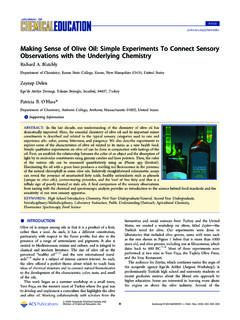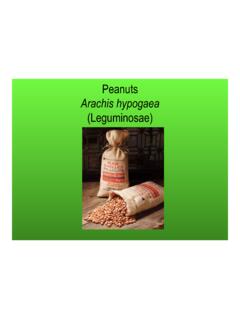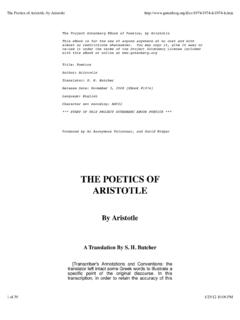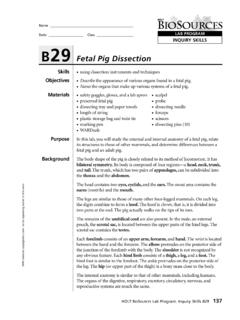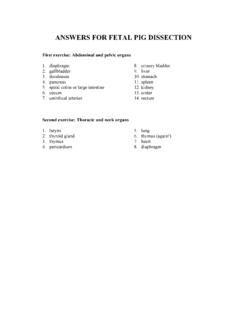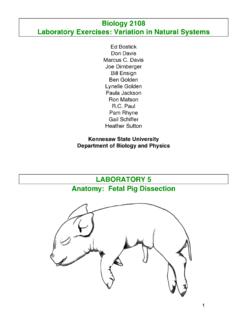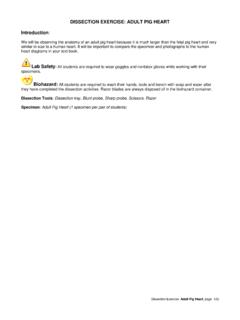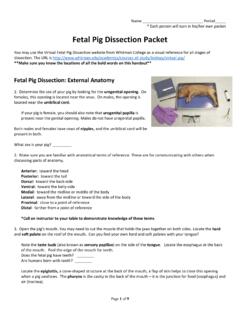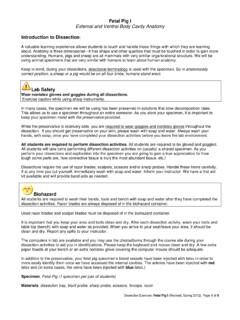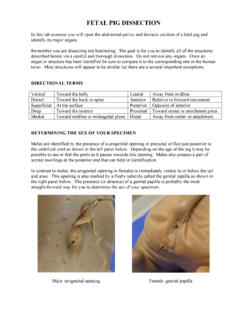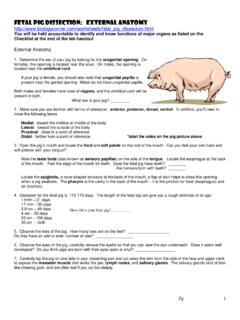Transcription of 2008 Vertebrate Organ Systems - Amherst College
1 Biology 18 Spring 2008 1 Lab 9 - Vertebrate Organ Systems Objectives: Understand the taxonomic relationships and major features of the chordates and the major classes of vertebrates Identify structures and their functions associated with major Systems - nervous/sensory, respiratory, circulatory, digestive and excretory - in different vertebrates Learn the taxonomic relationships between groups, to understand when similarities between structures are based on history (homology) or convergence Introduction: As you will recall from the Introduction to Animal Diversity handout, organisms need to carry out many processes to survive and reproduce.
2 During the next two weeks, you will examine the internal organs of vertebrates as a way of understanding their anatomy and physiology. As before, please approach your studies of Vertebrate anatomy and physiology as suggested on pp. 1-2 of the Animal Diversity handout. Once again, you should understand that similarities or differences in Vertebrate Systems are often a reflection of the environment in which an animal lives and the type of food that it eats. Finally, think about how the anatomical and physiological solutions of vertebrates compare with those that you observed earlier in invertebrates. Textbook Reference Pages: pp. 717-718 and 722 -741 Phylum Chordata The Phylum Chordata contains the group most familiar to you the vertebrates .
3 The members of this phylum are distinguished by: 1) They are triploblastic, possessing an ectoderm and endoderm, and a middle tissue layer, the mesoderm. They are coelomate, possessing a true body cavity lined on all sides by mesoderm-derived tissues. 2) Chordates are bilaterally symmetrical. 3) They have a notochord, a flexible supportive rod that runs longitudinally through the dorsum. 4) Chordates have a dorsal hollow nerve cord, which lies dorsal to the notochord. 5) They possess pharyngeal gill slits, which lie between the oral cavity and the esophagus. 6) Chordates also have a postanal tail. These features may not be present throughout the life cycle of chordates, but may only appear during the embryological stages of development.
4 The phylum is divided into three subphyla: Subphylum Urochordata, the tunicates. Subphylum Cephalochordata, the lancelets. Subphylum Vertebrata, the vertebrates , and the only group of chordates that we will look at in lab. 2 2 Specimens of vertebrates The focus of these labs is for students to become familiar with the Organ Systems of vertebrates (as compared to invertebrate Systems ), and along the way you should become more familiar with the taxonomy and major features of different groups of vertebrates . There are several classes in the Subphylum Vertebrata, and we will look at six in lab: Class Chondrichthyes sharks, skates and rays: the cartilaginous fishes (Dogfish) Class Actinopterygii bony fishes (Perch) Class Amphibia amphibians: frogs, salamanders, newts, etc.
5 (Frog, Mudpuppy) Class Reptilia reptiles: snakes, lizards, crocodilians, etc. (Snake) Class Aves birds (Pigeon) Class Mammalia mammals (Pig) Students will have two weeks to examine these materials. Careful dissections of the following specimens should be performed by all students, with suggested group size indicated in parentheses. 1) fetal pig (2) 2) Sheep heart (2) 3) Sheep eye (2) 4) Dogfish shark (7-8) Please take your time with these dissections. Do NOT cut out and remove organs from the pig or sharks, as viewing structures in their relative positions within the animal is critical for understanding the function of each Organ and Organ system .
6 Also, we have fewer sharks, so please be especially careful with these specimens. Please do not try to dissect out the brain in the pig or shark, as we do not have the proper tools for opening up the skull cavity. At the end of each lab period, store the specimens in a tightly-sealed, labeled (with your names and lab day) Ziploc bag, and discard fat tissue, etc. in the yellow trash can in the front of the lab. An overview of how to approach your dissection of the fetal pig is on the next two pages. Please follow these guidelines to get yourself oriented. Then, we suggest that you focus in sequence on specific Organ Systems , to understand how individual organs of that system work together to carry out an overall function for the organism.
7 Thus, we have organized the remainder of this lab according to the particular physiological challenges that each Organ system addresses. Once you understand how each of the Organ Systems work in the pig, you should then compare and contrast the mammalian body plan with that of the other Vertebrate specimens in lab. In addition to performing a group shark dissection , a pre-dissected frog will be available for viewing on the front bench, as well as resin mounts of a dissected bird and snake. There will also be various microscope specimens, models and other resin mounts in the front of the lab. Finally, in lab, there will be several different dissection booklets and dissection guides in plastic sleeves to assist in your understanding.
8 ALL OF THESE MATERIALS ARE TO REMAIN IN LAB FOR ALL STUDENTS TO USE. Note: sharks will be available for dissection in the second week of this lab, and you should study all of their organs Systems at that time. 3 3 fetal Pig dissection Please review the Tips For Doing Good Dissections sheet on of the Introduction to Animal Diversity handout. During lab, you will be responsible for maintaining detailed laboratory notes of your observations. You are expected to be able to identify the structures on the following fetal Pig dissection Check List (p. 4) and to know the basic function of each structure. A detailed Power Point show of a fetal pig dissection is posted on the course Blackboard site, as well as several on-line dissection sites, for your out-of-lab perusal.
9 Place your pig on its back in the dissection pan and press down on its chest and abdomen to flatten it out. Then, keep the ventral surface open by tying the fore and hind limbs up with a piece of twine (your lab instructor will demonstrate how to do this). First, examine the external anatomy of your pig and use Figure 2 below to determine if you have a male or female pig. Next, follow the numbering sequence in Figure 3 to cut through the skin and body wall of the pig. As you examine the internal organs (Figure 4), you want to note how the organization of an Organ and its respective Organ system is related to the specific body function that the Organ carries out.
10 In addition, this is a good time to reflect upon the role of animals in teaching and research. As such, make sure that you treat your animal with the proper respect. ANATOMICAL TERMS AND PLANES: Figure 1. Anatomical terms and planes as applied to a tetrapod Vertebrate Anterior - Posterior (head to rear) Ventral - Dorsal (belly to back) Rostral - Caudal (nose to tail) Medial - Lateral (midline to side) Superior - Inferior (above to below) Proximal Distal (closer to/farther away from a point of reference) 4 4 fetal PIG dissection CHECK LIST ____ lungs and pleura ____ hard and soft palates ____ trachea and bronchi ____ pharynx ____ heart and pericardium ____ teeth and tongue ____ nose and mouth ____ nasal and oral cavities ____ rib cage and diaphragm ____ larynx ____ liver and gall bladder ____ abdominal cavity ____ umbilical arteries (2)
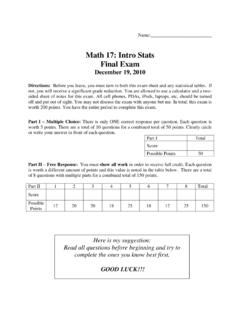
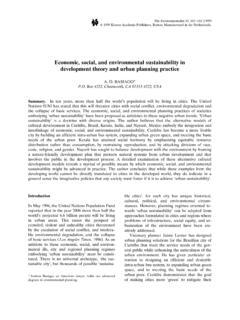

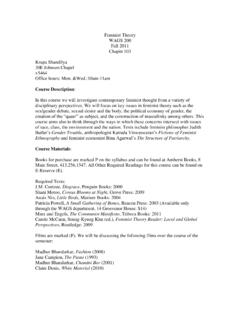

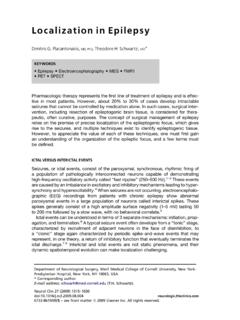
![[Fill-in-the-blank] tests measure and multiple choice ...](/cache/preview/5/e/e/9/b/f/1/7/thumb-5ee9bf17e1539b3a63fea89d05cad259.jpg)
